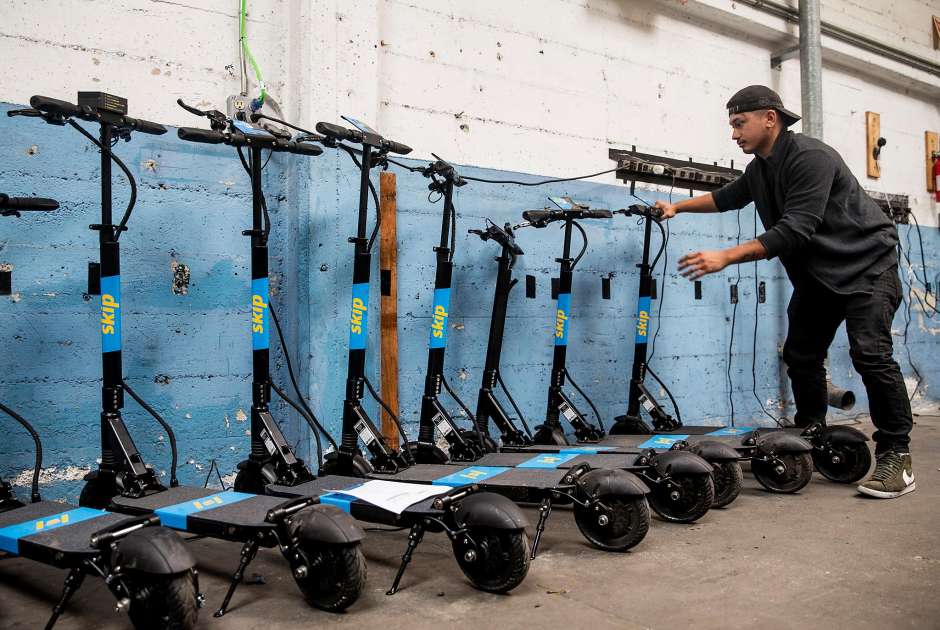
The disrupters are being disrupted.
Companies such as Uber established an “ask forgiveness, not permission” ethos, treating city streets like the software code they uploaded and updated with frenetic speed.
The playbook was simple: Swarm a town with your service, grow really big really fast, win over lots of customers, and enlist them as allies in lobbying to allow your business to operate. Not on that game plan: getting a go-ahead from civic leaders before rolling things out.
But increasingly cities from New York to San Francisco are fighting back.
Case in point: scooters.
While scooter companies followed the classic game plan when they dumped hundreds of electric two-wheelers here in March, it took only a few weeks for San Francisco to put the kibosh on them and create a framework that the companies had to work within.
On Thursday, the San Francisco Municipal Transportation Agency picked two smaller companies, Scoot Networks and Skip, for a one-year pilot program, snubbing well-funded players including Lime, Bird, Lyft and Uber’s Jump division.
“This is the first time the city got out in front of an issue, albeit the companies did deploy before regulation,” said Supervisor Aaron Peskin, a vocal critic of tech company excess. “San Francisco clearly learned lessons from the behavior some companies have exhibited in the past. It stuck to a profound principle: If you want to use the public right-of-way, it has to be in the public interest.”
His view: Mayor Ed Lee’s administration was too friendly to tech companies. “That led to a backlash for public opinion and legislative efforts,” he said. “We’re striving to find the sweet spot that balances all the needs.”
On the other hand, some tech observers say San Francisco could be in danger of squelching innovation if its regulations are too heavy-handed.
Its regulation of sidewalk delivery robots — allowing just eight for the entire city and limiting them to industrial areas — exemplifies what critics call a nanny-state tendency.
Some companies that failed to get a scooter permit are already crying foul, saying the process was too opaque. Lime said it will appeal the decision. Uber and Lyft said they are disappointed and still hope to rent e-scooters in the city one day.
But it’s not just scooters.
Uber and Lyft, the ride-hailing disrupters, face more and more blowback from cities — even though they are often regulated at the state level, as is the case in California.
Both companies in July compromised with Peskin on to the possibility of San Francisco taxing their rides in the city, rather than face the prospect of the city imposing a harsher tax via a ballot measure. On Friday, the Legislature passed a bill allowing San Francisco to have a 2019 ballot measure about the ride-hailing tax.
In New York, the City Council last month voted to freeze the number of ride-hail cars for a year while the city studies effects on traffic and livable wages.
Airbnb, the other giant disrupter, likewise is facing new barriers erected by cities. In its hometown, a bruising lawsuit forced it and other vacation-rental companies to knuckle under to the city’s requirement that all hosts register to ensure they abide by local laws. In New York, the City Council required home-rental companies to provide detailed data about hosts.
“Cities have learned from past experience and gotten more savvy,” said Sunil Paul, who founded Sidecar, a now-defunct San Francisco ride-hailing company. “The world has changed. We as a city and as a society need to rein in companies that abuse their power.”
Ride-hailing was a gray area when Sidecar came along in 2011. Sunil said the company had talked to the mayor’s office before starting service, but Sidecar, along with Uber and Lyft, received cease-and-desist orders from state regulators in 2012. California then crafted regulations for ride-hailing in 2013.
Still, he thinks that regulating by the numbers — such as capping the number of scooters — is an old-fashioned approach. “With all the technology available, we should be able to create a better system that takes advantages of location, data and all the rest so it can measure scooters’ behavior.”
But tech companies still have some juice with regulators.
In Santa Monica, Bird and Lime, which had pioneered e-scooters there, appeared poised to be shut out of the city’s pilot program when a rating scorecard placed Uber’s Jump and Lyft at the top. The two younger companies mobilized their users and on Thursday ended up getting permits for the city’s 16-month pilot program, alongside Lyft and Jump.

